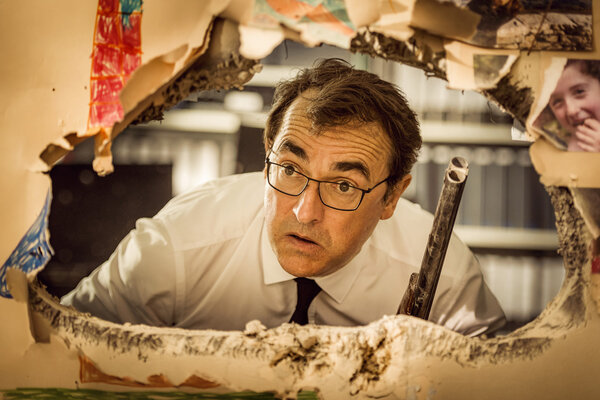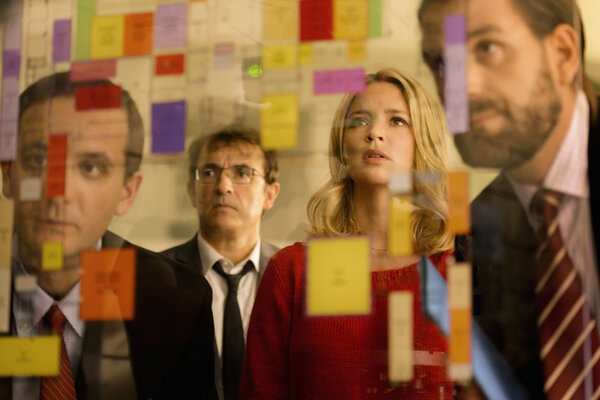Cinematographer Alexis Kavyrchine evokes his collaboration with Albert Dupontel on "Bye Bye Morons"
Albert’s Little WorldWhen, at the age of 43, Suze Trappet learns that she’s seriously ill, she decides to set off in search of the child she was forced to abandon when she was 15. Her administrative quest leads her to meet JB, in his fifties and in the middle of a burnout, and Mr. Blin, a blind archivist with an impressive dose of enthusiasm. The three of them embark on a quest that is as spectacular as it is improbable.
What’s it like to work with Albert Dupontel ? It’s said that he’s a real perfectionist…
Alexis Kavyrchine : Albert Dupontel has his own particular way of working. First of all, he spends a great deal of time preparing for his films, spending a lot of time trying things out, and gradually perfecting the artistic direction and the definitive way of creating his film. That means that there are a lot of camera tests, with or without the actors, certain props or prop lights in the film (like the computers at the beginning) and back-and-forths with the lab to find the right colors and contrasts and to develop LUTs so that they can be displayed precisely on set. He also storyboards his entire project and insists on having total control over the tools he uses to express himself as a director. That means that he is in very close collaboration with each department and each job on each crew. For example, concerning the camera department, he works closely with his camera operator and his grips, while the DoP is there to perfect the lighting with him and the gaffer. Personally, given the rapid shooting schedule he prefers, I thought it was appropriate to keep my distances from the camera work itself, and rather to devote my energies entirely to the image itself using the monitor.

How was the film shot ?
AK : It was shot very quickly. Very often, two cameras, sometimes even three, with sometimes very different field sizes, even though the two main cameras are often nearby one another in terms of their axis. On the other hand, the third camera is sometimes on a crane, at a pretty steep angle, such as on the roundabout scene (shot in studio). Everything is shot at the same time, with something particular to his cinematographic language : every shot must be instantly legible. Because editing takes place quickly afterwards, each shot must be immediately legible, no fuss, and the narration must be obvious. There might also be a few virtuoso camera movements or rather original directorial ideas, such as the car scene where everything is narrated visually through the reflection in the windshield between the camera and the characters inside.
How was that scene made ?
AK : Everything was handled in postproduction by Cédric Fayolle, of Mikros, who is one of the main parties responsible for the film’s look (he was also the director of the second crew). We shot a ton of plates that corresponded to what Albert had described in the screenplay, and then we inserted them later. Cedric also helped us out a lot on some outdoor day scenes, such as the scene in front of the church where the buildings under construction were added in digitally, as were some of the figures in the background. A world that is familiar to us, directly inspired by contemporary society and its issues. With a layer of fiction and fantasy in the image that causes the narration to shift over into a sort of dark and touching comedy.
There’s also that scene in the spiral staircase which tracks the characters in profile…
AK : The staircase shot was precisely described in the storyboard. Because that scene was going to be shot in studio, the art department crew and I decided to make a fake spiral staircase so that the camera would only have to make a “simple” vertical movement instead of a spiral, which would have very tough for the grips to carry out. It was pretty complicated to design it, but once we’d gotten it right, shooting took place quickly. In terms of lighting, I mainly lit the actors using little LED sconces that the art department incorpored into the staircase, and I only added a low level of very soft and enveloping light from underneath, which was impossible to detect despite the rotation of the set.

Weren’t you afraid at times that you were going too far in terms of contrast or colors ?
AK : Albert is truly someone who isn’t afraid to make image or staging decisions. Especially because he doesn’t mind doing retakes if it doesn’t turn out to his liking. For example, this happened on the opening scene at the doctor’s, which he didn’t like and which we reshot entirely. This situation is motivating for the cameraman, because they feel complete trust in the director… Even though sometimes that means mixing very saturated colors within the same scene (like the suburban house scene where the son lives hidden, with a very strong blue that contrasts with the sodium lighting in the street). We also went very far with the contrast especially in the opening scenes. With characters who are sometimes totally silhouetted and really dense blacks. In order to achieve that result, I had LUTs on set that we’d perfected beforehand during our tests. That allowed me to show Albert the final intention, while maintaining a slight margin of maneuver for later on, if need be, to be able to recapture a bit of detail in the shadows.
Let’s discuss the scene at the end of the film on the esplanade in front of the building…
AK : The outdoor night scene was shot in the 1,000 square meter studio at Bry-sur-Marne. Besides the ground and the benches, the art design crew set up a few other elements such as a few streetlamps and a few trees, and everything else had to be invented in postproduction. Blue backdrops covered the back of the fake esplanade, with the ability to interact with the elevator that went up and down and was remote controlled by JB from his laptop computer. The hardest thing for me was to come up with abstract lighting, and not being able to rely on an existing environment. By hanging powerful tungsten sources from the studio’s overhead grid, together with the sodium streetlamps set up by the art design team, I tried to strike the right balance between the night setting and the real lighting on the actors. I based myself off of the storyboard, my discussions with Cédric Fayolle, and the references provided by the art design team.
In my opinion, Cédric’s contribution was quite important. He’s responsible for at least half of the image on this scene. Also, since Albert has learnt over the course of his career to use digital effects, he is perfectly aware of what is or isn’t possible in that area.
Did you use any filters ?
AK : Because we were often shooting with three cameras at night, and frequently had light sources in the frame, I didn’t want to filter and create reflections, flares or parasite images of those lights. So I quickly gave up on the idea of filtering the Master Prime lenses that outfitted the Alexa. Especially since the color grading work was going to be such that the texture of the image could be refined later on, using digital diffusion filters, if needed. We even thought about adding graininess, but we dropped the idea since the modern aspect of the film didn’t lend itself to that.
Why the Master Primes ?
AK : The choice of lenses was especially related to the availability of the short focal lengths. Albert usually works with 10, 14, or 16mm lenses. Few series offer such continuity within that range of focal lengths. In any case, as we decided during our tests, the real work on the image rendering was done in color timing, rather than by the choice of camera and lenses.

What’s your takeaway ?
AK : I learnt a lot on this film, because the way we made it was unique. And because Albert has a way of doing things that is both risky and fully assumed. For example, I really liked the sort of simplicity in the choice of prop lighting. Using a sodium streetlamp as the only light source is a very strong and direct gesture. Or in his choice of colors, which are also very stark and very clean, such as in the blue house. This means that we find ourselves in a well-known and very real world, but where a detail inserted by the director makes us slip into the imaginary. Another example I’m thinking of is the scene in the metro, where the light comes from the passengers’ mobile phones. That’s a sort of wink to the viewer, who allows himself to slip into a fantasy world for the duration of the film…
(Interview conducted by François Reumont for the AFC, and translated from French by A. Baron-Raiffe)
Bye Bye Morons (Adieu les cons)
Director, Screenplay : Albert Dupontel
Art Design : Carlos Conti
DP : Alexis Kavyrchine
 En
En Fr
Fr





